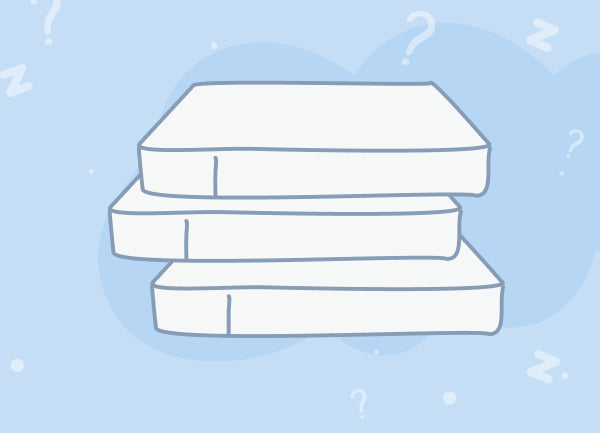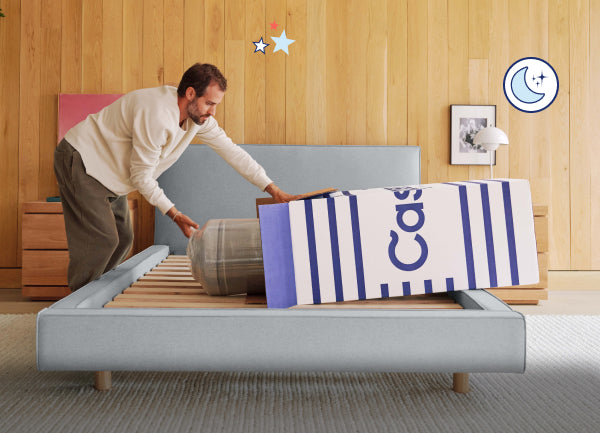Achieving that perfect night of rest requires bedding that fits your unique sleeping style. With so many terms being thrown around, where do you begin? The duvet — easily confused with a comforter or quilt — is a unique top layer that allows you to customize your bedding throughout the year.
So, what is a duvet? On a basic level, a duvet is a quilted blanket filled with a natural or synthetic filling — such as down or down-alternative — that is protected by an interchangeable cover. Unlike a comforter, its unique pillow-like structure traps heat without weighing you down.
The word duvet is used a bit more generally in Europe, but in the US, we define a duvet as a quilted insert unique from the comforter. In this guide, we’ll cover the duvet meaning and all you need to know about finding the best one for your ideal night of sleep.
Casper duvets are fluffy and cozy enough to bundle you up and ship you off to dreamland. Whether you sleep hot or want an alternative to down, we have a duvet for you.
What Is a Duvet Cover and What Is It Used For?

Let’s start with the duvet cover definition. A duvet cover is a fabric case that fits around your duvet and closes with buttons, snaps, or zippers. It allows easier washing, flexible design, and even a different feel under the covers. Here are a few important tips to know about duvet covers:
Confused about the difference between a duvet vs. a duvet cover? Shopping for the two main parts of a duvet set can be confusing. Remember that the duvet is the fluffy blanket inside the set and the duvet cover is the cozy shell that goes around it. You need both for a full duvet set.
How Does a Duvet Cover Work?
The next step is learning how a duvet cover works. Duvets slip easily inside the removable cover, a bit like a bed pillow in a pillowcase. Snaps, buttons, or ties inside the case keep the duvet in place to create one secure blanket.
The duvet cover has three main purposes: design, comfort, and convenience. For example, imagine shifting from your fall bedding to your holiday bedding without putting the whole comforter away. Duvet covers are easily swapped out to match the changing style of your room.
The duvet cover material also provides comfort variety. Break out the soft flannel on a cold January day and swap it out for lighter cotton when spring arrives.
Lastly, duvet covers help protect your duvet from rips, stains, and general wear. While you still need to wash your duvet, you can do it less often because of the cover.
You’re bound to see several different terms when shopping for a duvet. For example, what is a duvet set? When you buy everything together — the duvet, the duvet cover, and some matching bed pillow shams — you’ve got yourself a duvet set.

What Is a Duvet Insert?
The term “duvet insert” may also get tossed around when shopping for a duvet set. However, it’s actually just another way of saying duvet. The “insert” refers to the filled blanket that tucks inside the duvet cover.
What Is a Duvet Made Of?
The duvet itself is constructed to last for years and to adjust to different sleeping preferences. As we mentioned above, a duvet set has two parts: the removable cover and the filler. Just like shopping for sheets and comforters, the materials will determine the softness, weight, and heat of your bed.
Duvet Shell
The duvet itself is made up of a shell and filler material. The shell — also known as ticking — is often constructed of durable cotton or manmade fibers. A high thread count, preferably over 300, is crucial to keep the down and feathers inside the shell without sacrificing breathability.
The most common duvet shell materials are easy to clean, durable for long-term use, and highly breathable. You will often find them in white, cream, or gray, adaptable for all duvet cover designs.
Duvet Filler
What goes inside a duvet? The duvet filling material provides different levels of breathability and physical weight. They range from natural to synthetic fibers — down or feathers being the most traditional option. The filling is evenly distributed throughout the blanket for even comfort.

Inside you’ll typically find:
- Wool
- Down
- Feathers
- Cotton
- Microfiber
- Polyester
- Silk
We’ll explain how to choose the best materials for you below, including what goes inside the cotton duvet cover.
The Pros and Cons of a Duvet
Choosing between a duvet and a comforter is a matter of preference. It’s all about creating the right environment to sleep the whole night through.
Duvets allow much more flexibility for the look and feel of your bed, but some find them difficult to keep in place. Also, many sleepers simply prefer the traditional layered feeling of a comforter and bed sheet set.
A great duvet set is a big decision, so let’s touch on the pros and cons of this unique bedding style.
Pros
- Multiple options to customize the weight and warmth of your bedding.
- Hold in warmth without the weight.
- Flexibility to change your duvet cover by season and style.
- Easier to clean the cover without cleaning the whole set.
- Long-lasting materials are great for your budget.
Cons
- Duvet covers can be tricky to switch out.
- Some duvets don’t like to stay in place inside their covers.
- There is an additional purchase upfront since duvets and their covers may come separately.
- Washing the duvet insert requires more effort to maintain its fluffiness.
How to Choose the Right Duvet for You
Flexibility is always fantastic, but how do you choose a duvet set that checks all the right boxes? Work your way down our list to customize your best set.
1. Material
Always start with comfort. Do you suffer from allergies? You may want to choose a polyester shell and filler that is easy to clean — to get rid of dust or dust mites — and avoids potent chemicals. Merino wool is also known to help allergy sufferers and balance humidity.
Natural materials, however, are more likely to maintain breathability and fit your body shape. These include goose and duck down or feather, cotton, or even silk fillers.
Your shell and filler material will also dictate the weight of the blanket on your body and the amount of heat it holds inside. Check out your “tog rating” to determine the heat of your blanket — higher numbers are better for the fall and winter and low numbers are great for summer sleeping. Your fill weight, on the other hand, dictates how much of that “weighted blanket” feel you’ll get in bed.
2. Size
Just like your bed sheet sets and comforters, duvets come in the traditional sizes:
- Twin
- Twin XL
- Double
- Full
- Queen
- King
- California King
When in doubt, size up when choosing the right duvet for your bed. A little extra room will cover the bed frame without a bed skirt and be a bit easier to maneuver if you share your bed.
3. Cost
A durable and high-quality duvet can last years longer than a comforter, especially with fewer trips through the washer. To get the most from your duvet budget, be sure to look at the following factors:
- Filler Material: Natural materials often cost more than down-alternatives. Be sure that down is right for you before going this route.
- Construction: Your duvet should be constructed well. The traditional baffle-box pattern keeps the fill evenly distributed.
- Shell Material: High-quality shell materials wick sweat and improve breathability. A higher thread count also means that the duvet filler will stay inside longer.
4. Sleeping Environment
This is where all the other elements come into play. How do you like to sleep at night? Do you need a heavier blanket to keep from rolling back and forth? Choose a higher fill weight.
Warmth and breathability also play important roles. If you tend to warm up at night, a lighter tog rating may be for you. Do you sleep next to someone else? Their body heat will contribute to the experience under such a well-insulated cover.
When you live in a temperate climate with four distinct seasons, choose a duvet rated for four-season use. Duvet covers can adjust the feel of the blankets, but the filling will have the largest effect.
Where Can You Buy a Duvet?

Whether you’re looking for a french duvet or plush duvet, duvets sets of all varieties can be found online and in linen and home goods stores. As sleep specialists, Casper lets you choose the right duvet for your unique sleeping style and preferences.
We offer a range of traditional down duvets for year-round comfort, sustainably sourced down alternatives, and signature designs using sweat-wicking merino wool.
A duvet is one of the most popular choices for building a cozy, stylish, and long-lasting bed set. Its unmatched opportunities for customization allow you to personalize every detail of the duvet set—from the weight of the filler to the stylish cover. Choose a set that promises a great night of sleep all year round.
FAQ
What is a duvet set?
A duvet set includes a duvet insert, a duvet cover, and typically a matching pair of pillow shams. A Cotton duvet cover set, however, will typically include the cover and corresponding linens with the duvet insert sold separately.
Is a duvet a blanket?
Yes! A duvet is a type of blanket with interchangeable covers. The insert is made up of a quilted shell filled with natural or Yes! A duvet is a type of blanket with interchangeable covers. The insert comprises a quilted shell filled with natural or synthetic fluff. Duvets differ from comforters since they can be adjusted in style and feel by switching the cover out whenever you choose.













